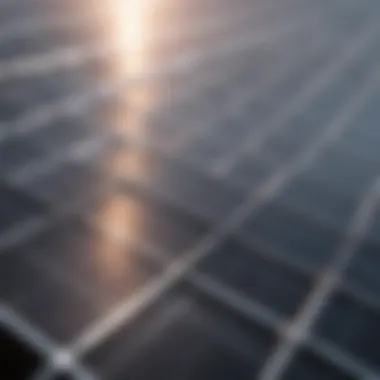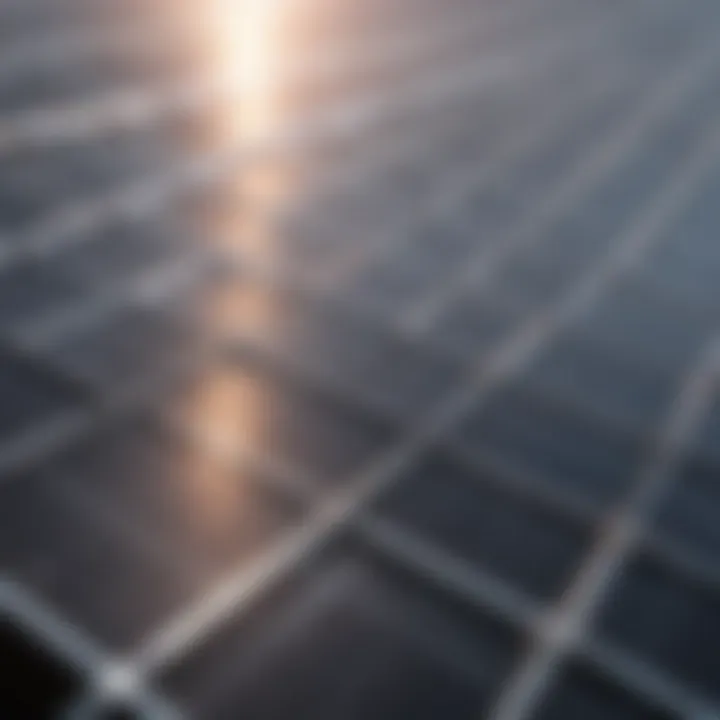Creating a Solar Panel: A Comprehensive Guide


Intro
The concept of solar energy has gained traction in recent years. Many individuals are searching for alternatives to fossil fuels. Solar panels offer a viable solution to harness energy from the sun. Understanding how to create these panels is crucial for innovation in renewable energy.
Solar panels convert sunlight into electricity using photovoltaic technology. This process involves distinct components and specific materials. The relevance of solar panels cannot be overstated - they offer a sustainable means of producing energy without depleting natural resources. As global energy needs continue to grow, implementing solar technology becomes increasingly important.
In this guide, we aim to provide a comprehensive understanding of the production of solar panels. We will dissect the elements involved, showcase essential materials, and describe necessary techniques. By illustrating these factors, readers will gain insight into both the science and technology that underpin solar energy production.
Intro to Solar Energy
The relevance of solar energy in today’s world is undeniable. As fossil fuels deplete and environmental concerns rise, the need for sustainable energy sources becomes increasingly critical. This section highlights why understanding solar energy is essential for anyone interested in renewable energy solutions.
Solar energy derives from the sun's radiation, which can be harnessed through various technologies. The production of solar panels, a key component in solar energy systems, significantly affects our energy landscape. Efficiently converting sunlight into usable electricity impacts not just industrial sectors but also individual households.
Understanding Solar Energy
Solar energy is radiant light and heat from the sun, harnessed through solar technologies such as solar heating, photovoltaics, and solar thermal energy. Photovoltaics, specifically, convert sunlight directly into electricity using semiconductor materials, primarily silicon. By grasping how solar energy works, you gain insights into how solar panels can provide a reliable, eco-friendly energy source.
Solar energy is abundant and available in many regions. This natural resource offers numerous advantages. It is renewable, which means it won’t run out, unlike oil or coal. Moreover, the decreasing costs of solar technology and improvements in efficiency make solar energy more accessible than ever.
Importance of Solar Panels
Solar panels play a pivotal role in harnessing solar energy effectively. They serve as the interface between the sunlight and the electrical grid or battery storage systems. Without solar panels, converting solar energy into usable electricity would be exceedingly difficult. Here are some reasons highlighting their importance:
- Sustainability: Solar panels help reduce dependence on fossil fuels, resulting in lower carbon emissions.
- Energy Independence: By using solar energy, individuals and nations can reduce their reliance on imported fuels.
- Economic Benefits: Investment in solar technology can lead to job creation in manufacturing, installation, and maintenance sectors.
- Energy Accessibility: Solar panels can provide electricity in off-grid areas, enhancing energy accessibility and quality of life.
"The transition to solar energy is not just an environmental choice; it’s a strategic economic decision for future sustainability."
Understanding solar energy and the critical role solar panels play opens the door for deeper exploration into how to create an efficient solar panel. This foundational knowledge sets the stage for the following sections, which will explore the components, materials, and steps involved in the solar panel manufacturing process.
Components of a Solar Panel
Understanding the components of a solar panel is essential in grasping how solar energy is harnessed. Each element plays a unique role in converting sunlight into usable electricity. A solar panel’s efficiency and longevity rely heavily on the quality and functionality of these components. This section will explore the primary parts of a solar panel: photovoltaic cells, the glass layer, the backsheet, and the frame.
Photovoltaic Cells
Photovoltaic cells are the heart of a solar panel. These cells are made primarily from silicon, a semiconductor material. Their function is to convert sunlight into direct current (DC) electricity through the photovoltaic effect. When photons from sunlight strike the silicon wafer, they energize electrons, creating a flow of electricity.
The efficiency of these cells is crucial. Higher efficiency means that more sunlight can be converted into electricity, making the solar panel more productive. Presently, monocrystalline silicon cells tend to be the most efficient option available on the market. They have a uniform appearance and can convert up to 20-25% of sunlight into electricity. Polycrystalline cells, while generally less efficient, offer a more cost-effective solution with efficiencies around 15-20%.
Glass Layer
The glass layer serves multiple important purposes in a solar panel. Firstly, it provides protection against environmental hazards, such as hail, wind, and debris. Often made from tempered glass, this layer is designed to withstand significant impact. Additionally, a transparent glass layer prevents dust and dirt from accumulating on photovoltaic cells, ensuring they capture maximum sunlight.
A well-manufactured glass layer does not only deliver durability, but it also facilitates light penetration. Anti-reflective coatings on the glass can enhance the amount of light reaching the photovoltaic cells, boosting overall efficiency.
Backsheet
The backsheet is a protective layer that resides at the back of the solar panel. Its role is primarily protective, just like the glass but on the opposite side. Backsheets are usually made from a polymer material that is both weather-resistant and insulative. This layer prevents moisture from penetrating the solar panel, which could lead to damage over time.


The backsheet also ensures good electrical insulation, safeguarding the solar panel from potential electrical hazards. A high-quality backsheet can extend the life of the solar panel significantly, making it a crucial element in panel construction.
Frame
The frame of a solar panel is often overlooked but is pivotal for structural integrity. Typically made from aluminum, the frame provides stability and support, allowing the solar panel to withstand external forces such as wind and snow. Furthermore, it facilitates easy mounting and installation on various surfaces.
It also plays a part in enhancing heat dissipation, which is important as solar panels operate less efficiently at higher temperatures. Thus, a well-designed frame both protects the panel and can positively influence performance over its lifespan.
Materials Required
The topic of materials required for solar panel creation is crucial because it directly influences the efficiency, durability, and overall performance of the panels. Understanding the distinct types of materials used helps in making informed choices during the manufacturing process. Different materials serve specific functions that contribute to energy conversion and protection from environmental factors. Selecting the right materials affects not only the energy output but also the lifespan and reliability of the solar panel.
Silicon
Silicon is the cornerstone of modern photovoltaic technology. It is the material that enables the conversion of solar energy into usable electricity. Silicon comes in several forms, including monocrystalline, polycrystalline, and amorphous silicon. Each type has its own advantages and drawbacks.
- Monocrystalline Silicon: This type has a high purity level, leading to better efficiency rates. Typically, it can convert above 20% of solar energy into electricity. However, it is also more expensive to produce.
- Polycrystalline Silicon: This variant is less costly and easier to manufacture. It typically has a slightly lower efficiency, around 15% to 17%, but it still serves as a popular choice for residential solar systems.
- Amorphous Silicon: Commonly used in thin-film solar cells, this form is less efficient but offers advantages in flexibility and weight. It is a good option for applications where space is constrained.
Silicon's crystalline structure facilitates electrons to move freely when exposed to sunlight, a process critical to generating electricity.
Conductive Materials
Conductive materials play a pivotal role in connecting the solar cells within the panel and transferring the generated electricity. The most commonly used conductive materials include silver, copper, and various conductive adhesives.
- Silver: Given its excellent conductivity, silver is often used for making metallic contact on solar cells. Though costly, it ensures maximum efficiency in electricity flow.
- Copper: This material is generally used for wiring and providing a conductive pathway between the solar cells. It is more affordable than silver and still offers good conductivity.
- Conductive Adhesives: These materials not only bond components together but also serve as conductive pathways. This dual function can reduce the number of parts needed, simplifying the assembly process.
Effective integration of these materials is essential for enhancing energy output and overall solar panel performance.
Adhesives and Sealants
Adhesives and sealants are key components in maintaining the structural integrity and longevity of solar panels. They protect the internal elements from moisture, dust, and other environmental factors that can induce deterioration.
- Adhesives: These materials are used to secure layers of the solar panel together, such as bonding the glass layer to the photovoltaic cells. They must withstand extreme temperature changes and UV exposure.
- Sealants: These serve to fill gaps and prevent water ingress. They are critical in protecting the solar panel from potential damage and improving its lifespan.
Choosing appropriate adhesives and sealants can significantly reduce maintenance costs over time while safeguarding against wear and degradation caused by environmental factors. It is crucial to use products specifically designed for solar applications to ensure optimal performance.
Understanding the materials required for creating a solar panel is essential for making informed decisions that lead to better energy production and panel durability.
Basic Principles of Photovoltaics
Understanding the basic principles of photovoltaics is crucial for anyone interested in creating solar panels. These principles underpin the technology that converts sunlight into electricity. A solid grasp of how photovoltaic cells function and the conversion processes involved not only informs the design and creation of solar panels but also enhances their efficiency and effectiveness in producing energy.
How Photovoltaic Cells Work
Photovoltaic cells, often called solar cells, are the heart of solar panels. These cells are made primarily from silicon, a semiconductor. When sunlight strikes the surface of a photovoltaic cell, it excites electrons in the silicon. This movement of electrons generates a flow of electric current.
- Light Absorption: The cell absorbs sunlight. The energy from the light is transferred to electrons in the silicon.
- Electron Movement: When the electrons are energized by this absorption, they can move freely within the silicon material.
- Electric Current Generation: Through the doping process, two types of silicon are created within the cell. One type has extra electrons (n-type), while the other has fewer electrons (p-type). The interface between these two types generates an electric field. This field aids in directing the free electrons towards the external circuit, creating an electric current.
The efficiency of these photovoltaic cells is affected by several factors, including the quality of the silicon, the design of the cell, and environmental conditions like temperature and sunlight intensity.
Conversion of Solar Energy


The conversion of solar energy into usable electrical energy is fundamental to the function of solar panels. This process starts when photons from sunlight strike the photovoltaic cells. Here’s a more detailed look at how this process occurs:
- Photon Interaction: Photons interact with the photovoltaic material, transferring their energy to electrons.
- Electric Field Activation: The electric field generated in the cell drives these energized electrons towards the circuit, producing direct current (DC).
- Inverter Role: Since most homes and businesses use alternating current (AC), an inverter is necessary to convert the collected DC into AC. This makes the energy produced by solar panels usable for everyday applications.
The efficiency of this conversion process is often quantified as the "conversion efficiency" of the solar panel. Improvements in materials and technologies are continuously being made to enhance this efficiency, ensuring that more sunlight is converted to usable energy.
Understanding these basic principles of photovoltaics is essential for optimizing solar panel design, enhancing energy production, and pushing towards sustainable energy solutions.
Knowledge of these mechanisms supports informed choices in the design, installation, and implementation of solar energy systems, positively impacting both energy efficiency and environmental sustainability.
Step-by-Step Guide to Creating a Solar Panel
Creating a solar panel is not merely about assembling parts; it requires a solid understanding of the materials and processes involved. This section aims to provide a meticulous guide on how to create a solar panel. The detailed steps outlined here serve as a critical reference for anyone interested in harnessing solar energy.
Gathering Your Materials
Collecting the right materials is essential for building an effective solar panel. You will need several specific components, which include:
- Silicon wafers: These serve as the core for photovoltaic cells.
- Glass: A protective cover that enhances durability.
- Conductive metals: For wiring and connections.
- Backsheet: This provides insulation and protection from moisture.
- Adhesives: Needed for securing layers together.
- Sealants: For waterproofing and durability.
Ensuring all materials are of high quality can greatly affect the efficiency of the panel once complete. Take time to research suppliers and choose materials that meet appropriate standards.
Preparing the Photovoltaic Cells
Preparation of photovoltaic cells is a crucial step in the process. Start by taking the silicon wafers and cleaning them to remove any contaminants. This can include dust, oils, or residues that could diminish their performance. After cleaning, the next step involves doping the silicon, which alters its electrical properties. Phosphorus is often added to create an n-type layer, while boron may be used for a p-type layer. This doping process increases the efficiency of energy conversion in the cells. A brief checking of the cells for integrity is also recommended before assembly.
Assembling the Panel Layers
The assembly process involves layering the materials carefully. Start with the backsheet, which provides the foundation. Next, place the photovoltaic cells onto this backsheet with the conductive side facing up. Following this, apply the glass layer carefully to cover the cells. Ensure that the glass is securely bonded using appropriate adhesives. This layering approach is vital as it protects the photovoltaic cells from environmental factors while allowing sunlight to penetrate efficiently.
Wiring the Solar Panel
Wiring is essential for connecting the photovoltaic cells to form a functional unit. Use conductive materials to link the individual cells, ensuring that each connection is secure. It is crucial to create a series connection to ensure that the voltage generated is sufficient for the intended application. Be meticulous about polarity; incorrect wiring can lead to suboptimal performance or system failure. Once wiring is complete, check all connections thoroughly.
Testing the Solar Panel
Testing the assembled solar panel is the final and critical step before installation. Use a multimeter to measure the voltage and current output of your panel under sunlight. This process will verify the electrical performance and identify any discrepancies in energy production. If results do not meet expectations, revisit the previous steps to ensure that all components are functioning properly. Testing is not just a formality; it validates the effort put into the project and ensures reliability once installed.
"Testing is not merely a step but a commitment to quality in solar energy production."
Understanding these steps can empower individuals and organizations to produce efficient solar panels tailored to their needs. Each phase requires attention to detail, precision, and knowledge of materials to ensure an effective end product.
Installing Your Solar Panel
Installing a solar panel is a critical phase in the solar energy production process. The quality of installation directly impacts the performance and efficiency of the panels over time. A well-installed solar panel system can optimize energy output, reduce maintenance needs, and extend the overall lifespan of the equipment. This section explores key elements such as site selection and mounting techniques that need to be attended to during the installation process.
Selecting the Installation Location
Choosing the right location for your solar panel is essential. The placement needs to allow for maximum sunlight exposure throughout the day. Factors to consider include:


- Sunlight Availability: Areas that receive full sun for most of the day are ideal. Avoid spots that are shaded by buildings, trees, or other structures.
- Roof Orientation and Angle: For rooftop installations, south-facing roofs typically gather the most sunlight in the Northern Hemisphere. The angle of the roof should also be considered, as a tilt can further enhance sunlight exposure.
- Proximity to Power Source: The panels should be placed near the location where the electric power will be consumed to minimize power loss during transmission.
- Local Regulations and Permits: Always check local zoning laws, as some areas have specific regulations surrounding solar panel installations.
Taking these points into account can ensure that the solar panel system operates efficiently.
Mounting Techniques
Once the ideal site for installation is determined, the next step involves choosing appropriate mounting techniques for the solar panels. The methods used can greatly affect the stability and efficiency of the setup.
- Fixed Mounts: This is the most common type where panels are mounted at a fixed angle. It is simple and cost-effective. However, it does not allow for adjustments based on the position of the sun.
- Adjustable Mounts: These systems allow for angle adjustments, which can help to optimize solar energy capture throughout different times of the year. However, they require more maintenance and can be pricier than fixed mounts.
- Tracking Mounts: This advanced option follows the sun's progression across the sky. Although it provides the greatest energy output, it is generally more complex and expensive to install and maintain.
If you choose the right mounting technique, it can help to significantly enhance energy production while ensuring that the panels remain secure in various weather conditions.
Proper installation and careful attention to detail in mount selection and location can drastically improve the solar panels' overall performance and energy efficiency.
Maintenance and Troubleshooting
In the realm of solar energy systems, maintenance and troubleshooting hold significant importance. Regular maintenance ensures that solar panels operate at optimal efficiency. As with any technology, wear and tear can occur over time. Therefore, understanding how to maintain and quickly troubleshoot any issues is vital for longevity and performance.
The benefits of meticulous maintenance are numerous. First, properly maintained solar panels can sustain or even enhance their energy output levels. Second, regular assessments can identify potential problems before they escalate into more serious issues. Waiting until a panel stops functioning completely can lead to longer downtimes and higher repair costs. By taking proactive measures, users can save time and money, and contribute effectively to energy production.
Additionally, it’s crucial to take into account factors such as weather, environmental conditions, and system type. For instance, areas prone to heavy dust or snow require more frequent inspections and cleaning. This section aims to equip the reader with practical insights into regular maintenance practices and guidance on identifying common issues that may arise in solar panels.
Regular Maintenance Practices
Establishing a routine for maintenance can have a notable impact on the performance of solar panels. Here are some effective practices:
- Routine Inspections: Conduct visual inspections at least twice a year. Check for any signs of damage, dirt accumulation, or shading from trees.
- Cleaning Panels: Wash solar panels to remove dirt and debris. Depending on the location, it may be necessary to clean them every few months. Use water and a soft cloth or a squeegee for this task.
- Check Inverter Functionality: The inverter is a key component. Regularly inspect its performance through the monitoring system. Ensure that there are no fault codes or alerts indicating a malfunction.
- Inspect Mounting Equipment: Assess the mounting structures to ensure they are secure and not showing signs of corrosion or wear.
- Document Performance: Keep monthly records of energy production. Sudden drops could indicate equipment issues needing attention.
Following these practices enables users to maximize the efficiency and lifespan of the solar system.
Identifying Common Issues
Despite regular maintenance, some issues may still arise. Here are common problems to watch out for:
- Dirt and Debris Build-Up: Accumulation of dirt can significantly reduce solar panel output. Inspect panels to ensure they are clean.
- Electrical Issues: Faulty wiring or connection problems can cause interruption in energy flow from the panels to the inverter. Any unusual behavior or noises coming from the inverter should be investigated promptly.
- Aging Components: As solar panels age, they may develop reduced efficiency. Determine if any panels are underperforming compared to others in the array.
- Shading from Vegetation: Ensure that growing trees or nearby structures do not cast shadows over the panels. Regular trimming may be necessary.
Keeping a close watch on these indicators will help maintain your solar energy system effectively and minimize any downtime.
By establishing profound understanding of these maintenance practices and being aware of common issues, one can ensure the solar energy system remains productive and efficient over time.
End
The conclusion of this article underscores the significance of understanding how to create a solar panel. It is not simply about assembling materials but grasping the science and engineering behind solar energy conversion. By summarizing key processes and considerations, this section aims to reinforce why solar panels matter in today's energy landscape.
Summary of Key Points
In this comprehensive guide, several critical points have been articulated:
- Core Components: Understanding the necessary components such as photovoltaic cells, glass layers, and frames is essential. These elements work together to capture and convert solar energy efficiently.
- Materials Selection: The choice of materials, particularly silicon and conductive materials, play a pivotal role in the performance of solar panels. High-quality materials can optimize energy conversion and enhance durability.
- Manufacturing Process: The step-by-step guide provided offers practical insights for both enthusiasts and professionals. Each phase, from gathering materials to testing the panel, is crucial for successful solar panel assembly.
- Maintenance: Regular maintenance is vital for the longevity and efficiency of solar panels. Identifying common issues can prevent significant energy loss.
- Future Trends: The ongoing advancements in solar technology, such as increased efficiency rates and storage options, highlight the importance of staying informed in this rapidly evolving field.
Future of Solar Panel Technology
Looking ahead, the future of solar panel technology holds exciting possibilities. Innovations such as perovskite solar cells show great promise in terms of efficiency and cost-effectiveness. These materials can potentially transform solar energy harvesting, making it more accessible to a wider audience.
Moreover, integrating solar panels with smart home technologies will enhance energy management. The rise of energy storage solutions, like Tesla's Powerwall, allows better utilization of harvested solar energy. This development is significant for users who wish to maximize their energy independence.
Investment in research and development continues to uncover new approaches in solar technology. As public demand for renewable energy increases, the solar industry will likely focus on sustainability and reduced environmental impact.







